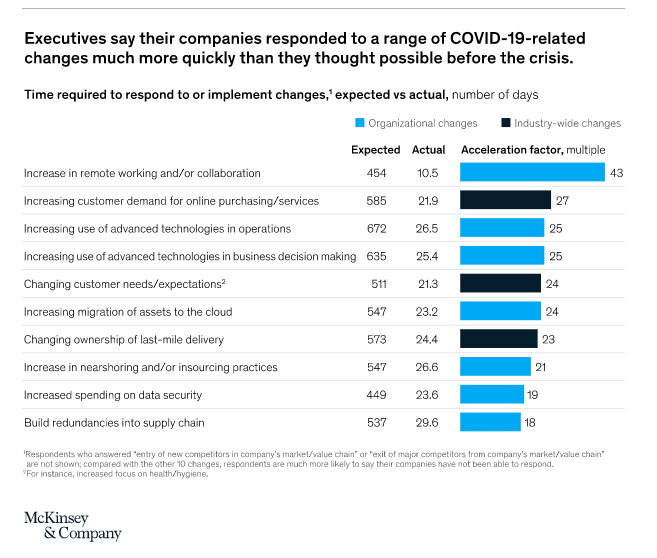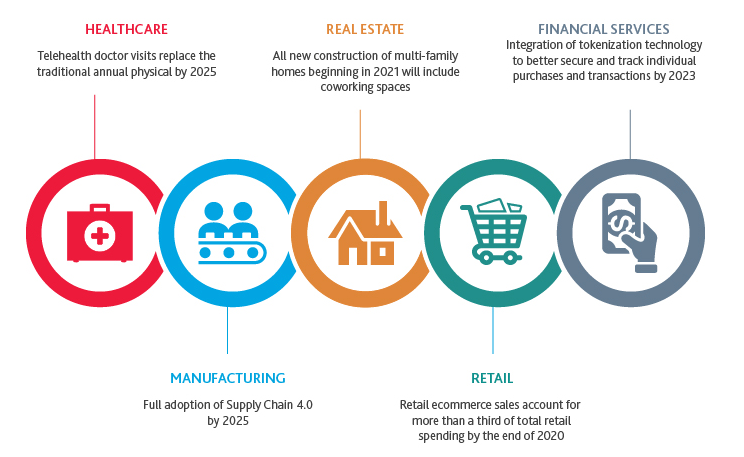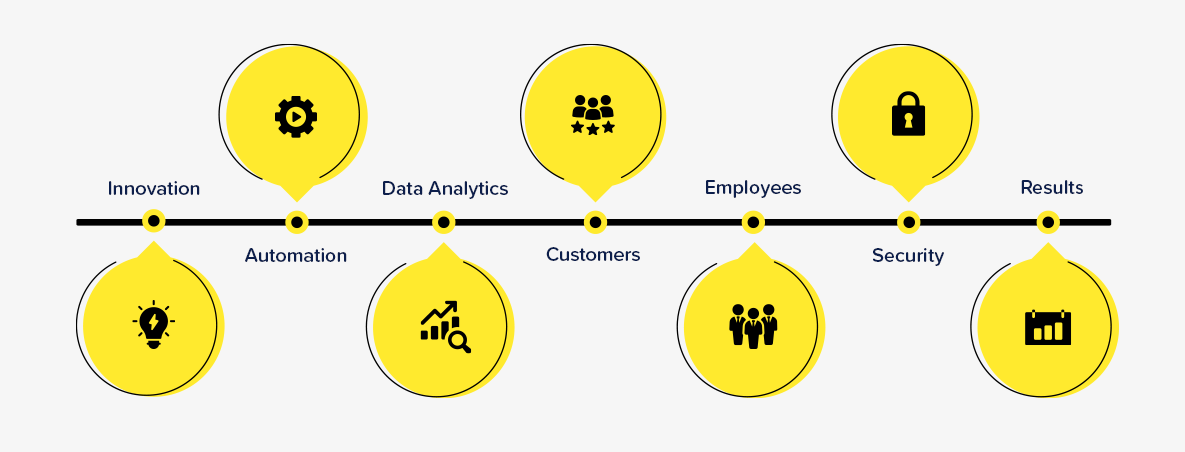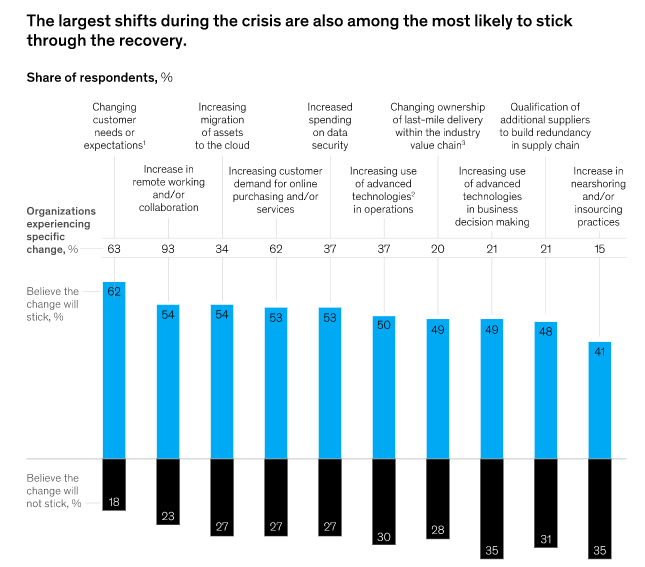The pandemic put the entire world on halt. A microscopic virus that couldn’t even be seen with a human eye was responsible for stalling the world to a standstill. From schools to offices, everything was closed. With social distancing and quarantining being the only solution to battle the pandemic, that was to be expected. Yet, we had to continue living and we did.
The pandemic brought along one disaster after the other, the count of lives lost could never be supplemented, the count of businesses that were forced to shut down was disturbing and the value of livelihoods lost was another feather in the hat of the COVID.
Nothing good came out of COVID. Even a year after the pandemic hit, we are all still adjusting. Yes, life went on, but are we the same? Is the way we conduct ourselves on a daily basis the same? Is the way we run our businesses the same?
The answer to all of these questions would be negative. I am not here to get into the lifestyle changes, since I am no expert at that. However, I would like to talk about the changes COVID brought to the business world. Yes, there were quite a few areas that businesses had to accommodate themselves in. Yet there was one aspect in particular that called urgency, ubiquity and progressiveness; and that was the amalgamation of the business world into the digital space.
And that is what we are going to be scrutinising today. How COVID accelerated digital transformation and would that be a long term solution? So let’s get started.
The Pandemic Called for a Faster Solution
Like I said above, the pandemic changed a lot of things for us and the way we conducted business was one of them. COVID moved at a really fast pace and we had to move at a faster pace to catch up with it.
The pandemic’s social norm was distance. This meant people could not come in close contact and businesses that operated on close contact needed to rethink their modus operandi, at least the ones that could. The only solution in sight was going digital.
The way the business world was changing pre-pandemic would have brought along digital transformation eventually, the pandemic just became the tipping point that came in sooner than the eventual change. Nobody can deny that businesses all over the world had the intention of going digital. It was just factors like;
Lack of technical infrastructure;
Lack of leadership;
Presence of organisational silos;
Fear of consumer resistance;
Other changes taking priority over digitalisation;
And plain and simple procrastination;
That meant businesses were not ready and willing to tip over the digital space. With COVID and the doom of failure, procrastination became anticipation and the business world started its journey towards the path of digital transformation. Learn how businesses reimagined themselves for the achievement of that goal in our blog, 'How the pandemic pushed the business world to reposition itself?'
It became clear that consumers were rapidly moving towards digitalisation and majority of the consumer interaction was becoming digital in nature. There was clearly no way out of building a digitally transformed business. With that in mind, the only question was how long would it take. And the answer was not long.
The pace at which businesses are moving towards digital transformation post-pandemic is astounding to say the least. The speed at which organisations are cooking up and providing their digital offerings, in the form of products and services, is at a seven- year increase. This increase is across geographical regions.
Digitalisation is pretty evident in the post-pandemic world and its pace is quite hurried. Regardless, the development rates of digital products and services are different for many organisations.
For instance, an automobile company cannot digitalise its manufacturing process, no matter how desperately it might want to; there is no possibility at all. The same is true for consumer packaged goods. Nonetheless, a healthcare provider, a financial institution (Read how digital transformation can bring about a big change in the FinTech industry to know more about its significance) or a professional service provider can create digital products, as many as they want. This is why the development of digital products across various sectors is not consistent with the scale of digitalisation across various regions.

The chart above states all the changes that took place post-pandemic that lead the companies one step closer to digital transformation and how quick the companies were in adapting these changes; which is extremely quick.
I wouldn’t be wrong in saying that the pandemic came like a freight train and left digital transformation in its wake. So, maybe something good did come out of COVID or maybe I am just looking for a silver lining.
The Prequel of Digital Transformation: Investment in Technology
So far we have discussed that digital transformation was one of the few saving graces of the business world during and after the pandemic and that digital transformation happened at a much faster pace than could have been anticipated. Now comes the point, where we try to understand the beginning of a digitally transformed world, and that is technology.
One of the major impediments in digital transformation is lack of a technical infrastructure like we discussed earlier. And when we talk about digital transformation, digital technologies are the only ones that play a significant role. Without cutting edge technology, can you really think about leaving a mark with your digital capabilities? I do not think so. The companies that have experienced an increase in revenue post-pandemic had heavily invested in digital technologies and it would be suffice to say that the investment paid off in leaps and bounds.
COVID has pushed businesses to experiment in digital technologies and this is why investment in them is becoming a priority making it the first step towards digital transformation. Technological investments can’t be done without thought, organisations have to prioritise the aspects that need digital technologies.
If we look at digital technologies per sector, we will find that every sector is different in terms of the technology usage and investment and even the outcomes they experience through the said technologies. Here is an image illustrating the same.

There is a new sense of reliance on technology that wasn’t present in the pre-pandemic times. Every sector and every activity we are performing today in the business sense resonates with digital technologies. Let’s take a look at some of them.
- Almost all of the global workforce shifted to remote working with improved digital collaborations;
- Almost all the physical stores had developed a digital presence that was omnipresent by working with multiple channels;
- Majority of the consumers became reliant on digital content to satiate their boredom;
- Many of the sick preferred and still prefer telemedicine and remote diagnosis instead of going to an actual doctor, especially in the USA;
- All of the educational institutions, be it elementary schools or graduate schools, had to accommodate to virtual classes as their only resort for continuity;
- Many businesses and organisations also had and have virtual conferences and events during the pandemic;
All of these are activities that became possible because organisations were adapting to a digital world. And without a proper technical infrastructure, this won’t have been possible. A simple task of keeping track of an employee’s work activities one day in a week requires some degree of digital investment.
And the fact that these changes we have experienced in the pandemic aren’t completely transitory speaks for the longevity and prominence of digital transformation. To know more, read about digital reinvention strategies when one goes paperless.
Digital Transformation: The Perfect Strategy
Digital transformation has proved its worth in the post-pandemic times, being the saving grace of the business world. The success rates are clear enough for the entire business world to start implementing a digitally powered strategy for revenue, growth and continuity.
We know that technology is at the heart of digital transformation, which essentially helped in adapting to the post pandemic world. Now, we will assess the various aspects of digital technologies that helped businesses cross the digital bridge, with the pandemic looming over.

Digital technology for innovation
There is a common misconception about digital technologies. It is that digital technologies are only a means to save a few bucks and that is all. Indeed digitalisation would save your organisation money, but that is just one part of the whole picture.
You can achieve a world of things with digital technologies, the opportunities are endless and knowing this is crucial.
Modernising and improving the existing capabilities;
Possessing a competitive edge over the competition;
Engaging with the consumers and attending to their needs;
Creating a culture that thrives on innovation;
Digital technologies have an ability to do this and so much and that too at reduced costs. With COVID looming over the business world, all of these capabilities were discovered and enacted upon and the businesses kept flourishing.
Digital technology for automation
Apart from reduced costs, technology is also associated with automation and that brings me to the next point. Contactless service became the only service the consumers wanted in the pandemic and still do. Organisations that provided that were able to maintain a higher level of goodwill in the market.
Incorporating digital processes into your organisation’s day-to-day operations will have a positive impact on your efficiency as it will eliminate any and all friction points that human contact often had. Availability issues, time wastages and delays will become a thing of the past as it has for the companies that have integrated their processes making it one streamlined digital method that is fast.
Digital technology for data analytics
Businesses are often reliant on data analytics for growth and increase in revenue. And digital technologies help in harnessing data analytics.
Pattern analysis;
Behavior analysis;
And machine learning;
All come as digital technologies that help you analyse consumer behaviour and become proactive. A consumer’s digital footprint can actually give your efforts the right direction through predictive analytics. In the post-pandemic world, that is the best option for guaranteed success.
Digital technology for customers
Since we were just talking about consumer data, I thought it was only wise to talk further about their role in digital technologies.
Customer experience is the driving force of any business. The better the CX, the better the chances of higher business growth. Thinking about your digital outcomes from the consumer standpoint will help you in that.

The pandemic changed the way businesses and consumers interact completely, which means the interactions have taken a digital route in the majority of cases. So, you have to use your digital presence to provide a CX that meets all the consumer needs. Be it online appointments, transactions or services, a consumer should not face any hurdles because the pandemic has posed far too many on them already.
Digital technology for employees
Coming on to the employees, a satisfied employee will always perform better than a dissatisfied one. And their performance is key for digital transformation. So, how does a business keep its employees satisfied?
The answer lies in their online work experiences. Virtual working or remote working is common in the post-pandemic days, the online work environment becomes key. If that isn’t at a satisfactory level, you might face a high employee turnover, which is almost never ideal, but post pandemic, it can be disastrous.
So, while keeping your consumer engaged and happy through digital technologies, you also need to pay attention to your employees’ satisfaction through the same.
Digital technology for security
Your digital transformation strategy should also accommodate security. Cybersecurity has become of the essence since all of the paramount operations of the business have become digital in nature. Any leaked information through a hack can have deleterious effects on the health of your organisation.
Through cyber attacks leading to data breaches, on average companies are losing as many as USD 3.86 million.
Therefore, thinking about cybersecurity and implementing a sound policy to impede such attacks is crucial. For instance, the use of VPNs has become quite common in remote working to prevent any attacks on the employee’s network, thus securing him and the organisation.
Digital technology for results
Digital technologies also have a tendency of overlapping. And COVID has sort of made the overlap a little wider. See, technical investments aren’t a new concept, organisations have been investing in technology since it became possible to invest in technology. With these investments going that behind in time and COVID adding a layer of urgency, there is a high likelihood of overlapping technical investments.
That is why you have to be very diligent with your digital technologies and their investments.
- You have to look for the software and capabilities that have already been tapped into in the past, this would eliminate the chance of redundancies.
- You have to assess your competition, look for areas of digital investments and the course they took to achieve that.
- Then you will look for gaps in the digital spectrum, a gap in services that will ensure you get the most out of your investment.
Investment in digital technology has to be done the right way. Digital transformation can be a difficult process and there is a lot at stake. One wrong move in one of your digital capabilities can ruin the course of the entire process and I’m certain we don’t want that.
Why Is Digital Transformation Here to Stay?
Digital transformation meant an accompaniment of large shifts in the way business is done. These shifts often affect a major part of an organisation’s working mechanisms. From the way assets are migrated to the use of advanced technologies in operations, several aspects of the working environment change with digital transformation.
Here is an image showing 12 of them, along with the proportion of people, who believe that these digital changes will be long term.

Now that we know a substantial proportion of people believe that digital transformation is here to stay, let’s try to understand the why.
Less costly in the long haul
The first predicament in the face of digital transformation is its cost, which many think is exorbitant. However, that isn’t always the case. The cost of an overhaul of the entire technical infrastructure is going to be exorbitant without a doubt. However, you don’t need to have to do an entire overhaul. You can, but in small proportions.
Some organisations do just that, they perform a pilot program with lower costs and limited resources, assess its success rate. Once they have adequate returns on the initial investment, they decide to scale up. So yes, digital transformation can be cost-effective.
More savings in the long haul
One of the prime takeouts from digital transformation is automation, which translates to savings in the short, medium and long haul. Let’s see why.
- With automation the chances of errors are minimal, which means cost savings.
- With automation the work is done faster, more productivity in the same time will make you more money.
- With automation, your workforce can devote their time to more important tasks, ultimately saving you money.
Then there is the fact that digitalisation enhances operational efficiency. And it is another important medium of curtailing costs in a crisis scenario.
Digital business model for the long haul
There were catastrophic losses experienced by many businesses in the pandemic. And there wasn’t any way to avoid them. Changes to the supply chain being one of them. Recovering from such a shift would take time, especially for the manufacturers.
In such scenarios, there isn’t any option, but to adapt the business model accordingly. In the pandemic, that business model had to be digital in nature. If you think about it, a business model that could counter the effects of a pandemic, should that not be implemented in the long haul as will?
New would be normal in the long haul
Digital transformation is a relatively new concept today. However, its benefits have been so many that it is quite likely to become normal.
Digitalisation is making organisations more efficient, more competitive, more intuitive towards consumer needs and certainly more profitable. With all of this being a result and that too in a pandemic, going back to what was is not even a question.
Furthermore, organisations have already invested in digital technologies, which for one means that they will always be equipped to handle remote workings and virtual interactions. With an investment in place, would turning back be wise?

So, if I had to give my two bits about digital transformation’s lifespan, I’d say it is quite expansive.
The Final Verdict
Digital transformation is here to stay and nobody can refute that. However, there are certain aspects of the digital turnover that are yet to be mastered by organisations that have taken it up.
- Organisations need to develop a level of resilience in their operations that will have room for technological innovations within the existing infrastructure. This would allow organisations to eliminate the bridge between the consumer and your technical teams, which was a common occurrence during the pandemic.
- Organisations have to work to improve their operational efficiency even further. Don’t just think about the present, let the future be a part of your organisation’s resilient solutions until that ideal ratio is in sight.
The pandemic has been brutal for the entire world, for the people and the businesses. Foreclosures and bankruptcies had become pretty common phrases, it was the leap into the digital space that gave the business world a reason to look forward to. And that reason should remain put for now and in the future.
Subscribe
Related Blogs
Trek n Tech Annual Retreat 2025: A 7-Day Workcation of OSL

OSL family came together for the Trek n Tech Annual Retreat 2025, a 7-day workcation set amidst the serene beauty of…
Exploring Drupal's Single Directory Components: A Game-Changer for Developers

Web development thrives on efficiency and organisation, and Drupal, our favourite CMS, is here to amp that up with its…
7 Quick Steps to Create API Documentation Using Postman

If you work with API , you are likely already familiar with Postman, the beloved REST Client trusted by countless…




